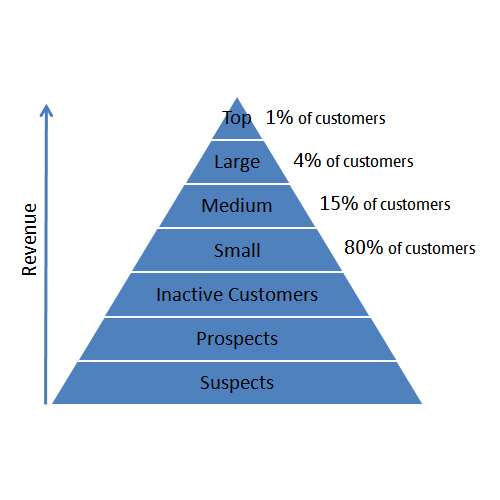
How Big Data Analytics Will Ruin Curry’s Customer Marketing Pyramid
In the eighties and nineties of the last century marketing gurus first taught us about CRM. People like Jay Curry, at the time director of Customer Marketing International, published about their discoveries related to a customer’s true value for a company. In his famous book “The Customer Marketing Method” Curry described how in most cases 20% of a company’s customers generated 80% of the revenue and that it therefore made sense to segment your customer’s into different categories and divide the company’s customer focus accordingly. In other words, Curry (and others) taught us to spend more time on trying to create loyalty within the top of your customer pyramid, and to think about different service models for less important customers.
In the days of Jay Curry’s publications the best source to measure the performance of a customer was the back office financial application. Curry therefore plead for ERP<>CRM integration to be an important aspect of each CRM software implementation. Today, we can make use of much more customer data, coming from many different external sources. We can deduct patterns in behavior per customer type from social media information, we can use location data, and we can analyze community and communication data. Most of this data is publicly available and the technology to analyze huge amounts of data by using No-SQL databases and Hadoop (-like) file storage systems is already there. More and more Big Data Analytics are offered as a service so, for example, a company only has to send the IP address of a website visitor to the service provider, to instantly receive a package of very useful characteristics and attributes, filled with information on the behavior and preferences of the person behind this IP address. These data then can be matched with the personas (arche-types of customers) defined, so as to be able to instantly deliver personalized messages to this customer.
And if we now take the use of Big Data Analytics one step further, it is easy to imagine that before too long companies will be capable of predicting beforehand whether a new customer will be a Top-of-the-Pyramid revenue dynamo, or just a low-revenue time and attention consuming bad customer. And if companies really start to trust these analytics, they might even refuse new customers based on their Big Data profile and their implicit web reputation. The use of Big Data analytics will then prevent the Customer Marketing Pyramid to evolve any further. And all customers will be profitable customers!
 Previous Post
Previous Post Next Post
Next Post
This is a great piece and you’re right to point to a future where it will be more routine for companies to inform prospective customers that their service isn’t likely to work for them. BUT, I think this model is going to require more than 2 categories. I think there’s got to be at least 3 categories in which a prospective customer is likely to at least “pay for themselves” in terms of revenue vs cost, even if they’re not triaged into that upper category of most profitable customers.